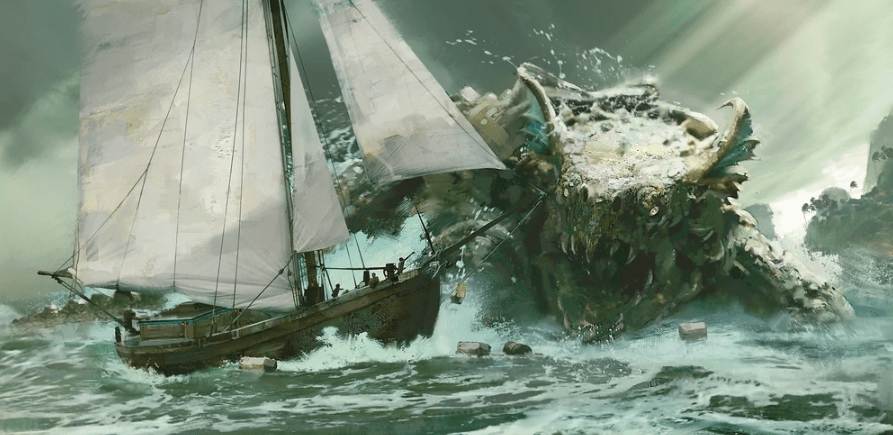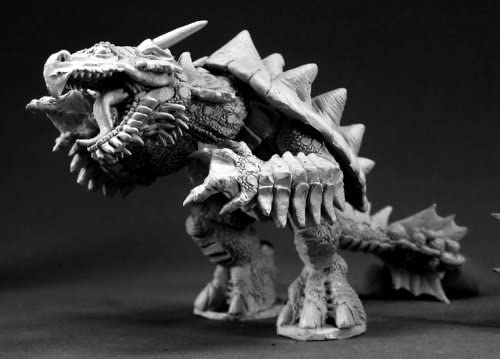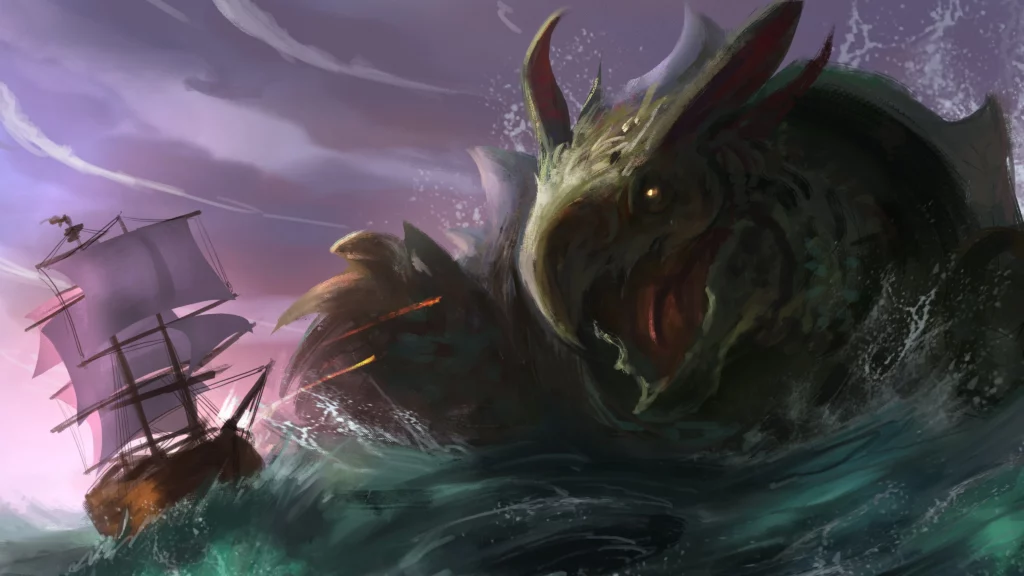The image of a dragon soaring over a medieval city and terrorizing the people below with its fiery breath is deeply ingrained in the DNA of the fantasy genre. Any fantasy fan has read about countless dragons, faced them throughout numerous video games and tabletop systems, and seen them depicted in shows and movies.
They’re iconic and intimidating, but what about a dragon that can easily speed through the water, terrorizing sailors and sinking entire fleets? That is where DnD’s Dragon Turtle enters the picture. Welcome to a Dragon Turtle 5e Guide.
Key Info Up Front
- Book: Monster’s Manual, page 303
- Challenge Rating: 17
- Editions: 1, 2, 3, 5
Dragon Turtle History in DnD

The Dragon Turtle was introduced to the first edition of DnD with the release of the supplemental book Monsters and Treasure in 1974. A similar creature from Chinese mythology heavily inspired the original design for the Dragon Turtle.
This is even seen in the monster’s original illustration when it was initially revealed. However, the monster’s design changed significantly with its appearance in DnD 2e. The two versions share near identical stats, but its second printing illustrates them in a much more turtle-like appearance.
The Dragon Turtle then returned in 3e with a rejuvenated stat block, although one that only gave them a relatively low challenge rating of 9. The illustration for the 3e version of the Dragon Turtle also deviated slightly from its previous depictions by giving it a more spiny shell and emphasizing its draconic nature more severely than its turtle-like elements.
Dragon Turtles then didn’t appear in 4e but made a return in the basic Monsters Manual of 5e. The monster’s return in 5e saw it re-claiming its rightful place as an intimidating and frightful monster.
This saw them getting a challenge rating of 17 and their official image returning to their appearance in 2e. They have more spiked shells alongside turtle-like jaws and features.
Dragon Turtle Lore

Dragon Turtles are believed to have a distant relationship with their ancestors, providing evidence for the draconic blood in their veins. This dragon blood has given them nearly impenetrable scales, massive shells measuring up to 25 feet in diameter, and a powerful steam-based breath weapon.
Various aspects of their personality also run parallel with the specific characteristics of traditional dragons.
The most immediately noticeable aspect of the Dragon Turtle’s draconic temperament is its penchant for building large hoards of treasure. They develop their hoards in their lairs that are made either in underground networks of caves or among extensive coral reefs that can sprawl across the seafloor for miles.
To build these hoards, they are well known for attacking merchant ships and fleets.
When they do so, they will sometimes demand an offering, allowing the ship to safely continue its journey as long as they pay, while other times, they opt just to attack and sink the vessel right away.
There have been many stories of Dragon Turtles even establishing their layers near a well-traveled trade route, making it well known that merchants and vessels following that route should prepare an offering for the Dragon Turtle before disembarking from their harbor.
Because of their love for shiny treasures, some Dragon Turtles can even be purchased as mercenaries. They have been known to be bought in such a way to work with pirates, Sahuagin, and Marids, often playing critical roles in battles for their employers.
Some Dragon Turtles have even been known to become powerful sorcerers in their own right, although these instances are so rare that they are considered mere myths and legends by some citizens of the Forgotten Realms.
The covetous and aggressive nature of Dragon Turtles has led them to live very solitary lives. Dragon Turtles can claim up to 50 square miles of sea to be their home territory, and they only allow other Dragon Turtles to enter their environment during mating season.
Otherwise, they are highly territorial and aggressive toward trespassers. If two Dragon Turtles fight one another, the winner traditionally consumes the other and takes over the other’s claimed territory.
Dragon Turtle Stats

With a challenge rating of 17, Dragon Turtles have pretty solid ability scores that illustrate their immense strength, hardiness, and average levels of intelligence. They have a Strength of 25 and a Constitution of 20, their highest two. These are followed by their Wisdom and Charisma of 12, while their Dexterity and Intelligence are a respectable 10.
Dragon Turtles also have a natural armor class of 20, 241 hit points, a base speed of 20 feet, and a swim speed of 40 feet. They are also innately resistant to fire damage, but since your party will likely only face a Dragon Turtle in water, they shouldn’t be using fire too much.
Dragon Turtles also innately understand the languages of Draconic and Aquan, but it is common for those who interact with merchants and sailors frequently to pick up Common.
They also have Darkvision up to 120 feet, helping them easily navigate the darkest and most profound areas of the ocean. They are also amphibious, meaning they can live both in and out of the water with little trouble.
Dragon Turtle Abilities
If your party ever faces a Dragon Turtle, they will have a tough combat encounter ahead of them, especially if they aren’t adequately prepared for a fight in the water. Their first attack is their Bite. It comes with a great +13 to attack rolls, a reach of 15 feet thanks to their extendable neck, and deals 3d12 + 7 piercing damage, averaging out to 26. Their second attack action is their Claw. It also has a +13 attack, a reach of only 10 feet, and deals 2d8 + 7 slashing damage, which averages out to 16.
Dragon Turtles also have a Tail action with a +13 attack and 15-foot reach. On a successful hit, the target takes 3d12 + 7 damage or an average of 26. When the target is hit with the Dragon Turtle’s tail, they also have to make a Strength saving throw with a DC of 20.
If they fail the saving throw, they are pushed back 10 feet and are knocked prone. Dragon Turtles also have a Multiattack action that they can use every turn. This allows them to make either one Bite attack and two Claw attacks or one Tail attack and one Bite attack.
The final Dragon Turtle action is called Stream Breath, which recharges on a recharge roll of five or six. This is the Dragon Turtle’s breath weapon, which takes the form of burning-hot steam that shoots from its mouth in a 60-foot cone. Any creature hit by the steam is forced to make a Constitution saving throw with a DC of 18.
If they fail the saving throw, they take 15d6 fire damage, averaging out to 52, but if they pass the saving throw, they only take half the damage. It is also important to note that if a player is underwater when they are hit with this attack, it does not affect the fire damage they take.
Playing a Dragon Turtle
Roleplaying

When you have to roleplay a Dragon Turtle, it is essential to emphasize the most significant elements of their personalities to make them stand out to the players of your party. You can interpret this in whatever way makes sense for your campaign and setting, but I approach this in the case of Dragon Turtles by having them be highly greedy, proud, and old.
When I roleplayed a Dragon Turtle for my party, I had them speak slowly with a deep, resonant voice. I would then have every interaction with the Dragon Turtle begin with it demanding an offering from the party members under the threat of attacking them if they failed to provide enough.
To make things easy, I wouldn’t expect a particular value or amount of currency from the party but would instead tailor it to the wealth level of my party so that they could always pay enough and try to be diplomatic with the Dragon Turtle.
Then, once they talk to the Dragon Turtle, I have it try to extort as much money from the party as possible. If they want information, it can be purchased for a price, or if they are rich enough, they could even pay for the Dragon Turtle to fight alongside them.
While they talk to the Dragon Turtle, I also like having them be very open that they expect money for their services, often having them just outright demand it even.
For the personality of Dragon Turtles, I also like to emphasize their pride from their draconic ancestry and their more bestial nature. To do this, have them threaten the party with their massive size and all the knowledge they have accumulated over their long lifespans.
To highlight their feral instincts and primal urges, you can also have them be quick to anger by having them threaten or intimidate the players and any NPCs nearby.
Combat

If you ever have a Dragon Turtle participate in combat, its actions will largely depend on whether or not your players are on a boat or just in the water. If the party is on a ship the Dragon Turtle’s primary focus should be getting them off the boat because it knows just how much more capable it is in the water compared to the mortal races.
To get the party off the boat, Dragon Turtles are known to ram their massive shells against the ship’s hull. Using this tactic, they can knock over even the biggest of boats ever made.
If ramming doesn’t work well to knock over the boat, Dragon Turtles will then opt to instead break through the hull and sink the ship, picking up any food and treasure as it floats to the sea floor. They would most likely do this with their Tail attack action, but they could also use either their Claw or Bite if that makes more sense for where they are.
It is also a viable option to have them get over the side of the ship and use their Steam Breath to attack those on deck, which is a great way to thin out the ship’s crew and intimidate the party at the start of the encounter.
While the Dragon Turtle rams a boat that your party members are on, you can also have them make Dexterity saving throws to stay on their feet. Then, if they fail too often or get a critical failure, you can have them fall off the deck and into the ocean.
This can help make the encounter a lot more dynamic as your players have to manage dealing damage to the Dragon Turtle while also trying to stay on the ship and safe.
Once one of the players falls into the water, the Dragon Turtle gets much more dangerous. Unless the player in the water is an aquatic species or has a magical item or spell, that helps them navigate better in the water, you may want to give them a disadvantage on their actions while they’re in the water. For the Dragon Turtle, you should take full advantage of its impressive swim speed to out-navigate the party members.
This can help them move quickly between each person in the water, hitting them with a devastating barrage of attacks. If they manage to kill any NPCs, I recommend describing it as the Dragon Turtle eating them, as this will make a lot of sense with its imposing size.
After your party manages to deal a lot of damage to the Dragon Turtle, you can also have it fly back to its lair to heal its wounds and bathe in its hoard of wealth. If the party can somehow navigate underwater well enough to follow the Dragon Turtle and get into its lair, you have a lot of freedom in describing it.
For some reason, Dragon Turtles aren’t considered legendary creatures in 5e, so the book doesn’t provide any information about their lairs or any optional lair actions.
When it comes to a Dragon Turtle’s lair, I have found it interesting to make it revolve around their incredible hoarding of wealth. You can have it integrated into the coral reef where the monster hides or build a sprawling network of caves that circle it, and it is easy for your players to get lost.
Because of how challenging of an enemy a Dragon Turtle is, especially underwater, I recommend rewarding your players with some fun magic items that disappeared into the sea many years before.
FAQs
Question: How giant are Dragon Turtles in 5e?
Answer: When they are an adult, Dragon Turtles can grow to be from 20 to 30 feet long, and they can weigh up to 32,000 pounds.
Question: Are Dragon Turtles considered true dragons in 5e?
Answer: They are directly related to ancient dragons and are considered true dragons. They are even classified as dragon-type creatures in the Monster Manual.
Question: Can Dragon Turtles fly like regular dragons?
Answer: No, Dragon Turtles cannot fly because they have evolved to be capable swimmers that rocket through the water.
Dragon Turtle 5e Guide: Final Thoughts
Dragon Turtles are a great monster to throw at a party that doesn’t know they exist in 5e. Their immense size and speed make them intimidating in their own right, but forcing players to fight in unfamiliar territories, such as on a boat or in the water, is also a great way to mix things up and push them to adapt quickly.
However, Dragon Turtles can also be helpful as plot points or NPCs. Their intelligence allows them to communicate with the players and their greedy nature offers a fun opportunity for players to persuade the Dragon Turtle to their side.
- Steel Defender 5e Guide - September 5, 2022
- Harengon 5e Guide - August 24, 2022
- Shambling Mound 5e Guide: The Most Terrifying Plant - August 21, 2022

